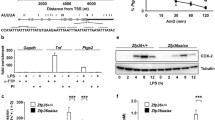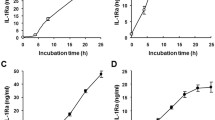Abstract
Lipopolysaccharide (LPS)-induced liver injury in mice and LPS-induced tumor necrosis factor-α (TNF-α) generation by murine macrophages and hepatocytes are suppressed markedly by agents that elevate intracellular cAMP. Phosphodiesterase (PDE)-4 inhibitors, β2-adrenoceptor agonists, and E-series prostaglandins also attenuate the induction of the TNF-α gene in human monocytes in response to bacterial LPS. The mechanism of action of cAMP is unclear, but in the mouse, is believed to involve the generation of the anti-inflammatory cytokine, interleukin-10 (IL-10). In this article, we describe the results of studies designed to determine the extent to which IL-10 contributes to the suppression of TNF-α generation from LPS-stimulated human monocytes evoked by 8-bromo cyclic AMP (8-Br-cAMP), rolipram, salbutamol, and prostaglandin E2 (PGE2). LPS evoked a time- and concentration-dependent generation of TNF-α (t1/2=4.5 h; EC50=273 pg/mL), which was inhibited by exogenous human recombinant (h) IL-10 (IC50=124 pg/mL), and by rolipram (EC50=420 nM), 8-Br-cAMP (EC50=77 (μM), PGE2 (EC50=15 nM) and salbutamol (EC50 = 20 nM). In addition, 8-Br-cAMP, PGE2, and salbutamol (but not rolipram) augmented significantly LPS-induced IL-10 production (two-to fivefold) under identical experimental conditions. Pretreatment of monocytes with an anti-IL-10 monoclonal antibody (MAb) that abolished the inhibitory action of a maximally effective concentration of exogenous hrIL-10, failed to attenuate the inhibitory effect of rolipram, PGE2, salbutamol, and 8-Br-cAMP. Anti-IL-10 was similarly inactive when the number of monocytes seeded was increased from 0.5 to 4 × 106/mL or when measurements were made at 42 h post-LPS, a time when the concentration of IL-10 released was maximal. Collectively, these data suggest that in contrast to murine hepatocytes and macrophages, IL-10 does not mediate the inhibitory effect of cAMP-elevating drugs on TNF-α generation from human monocytes. Although the reason for this discrepancy is unclear, we suggest that the influence of cAMP on the transcriptional regulation of the TNF-α gene differs between species or when monocytes have differentiated into macrophages.
Similar content being viewed by others
References
Giembycz, M. A., Dent, G., and Souness, J. E. (1997) Theophylline and isoenzyme-selective phosphodiesterase inhibitors, inAllergy and Allergic Diseases (Kay, A. B., ed.), Blackwell Scientific, pp. 531–567.
Torphy, T. J. and Undem, B. J. (1991) Phosphodiesterase inhibitors: new opportunities for the treatment of asthma. i46, 512–523.
Giembycz, M. A. (1992). Could isoenzyme-selective phosphodiesterase inhibitors render bronchodilator therapy redundant in the treatment of bronchial asthma?Biochem. Pharmacol. 43, 2041–2051.
Giembycz, M. A. and Dent, G. (1992) Prospects for selective cyclic nucleotide phosphodiesterase inhibitors in the treatment of bronchial asthma.Clin. Exp. Allergy 22, 337–344.
Nicholson, C. D. and Shahid, M. (1994) Inhibitors of cyclic nucleotide phosphodiesterase isoenzymes—their potential utility in the therapy of asthma.Pulmonary Pharmacol. 7, 1–17.
Dent, G. and Giembycz, M. A. (1995) Selective phosphodiesterase inhibitors in the therapy of asthma.Clin. Immunother. 3, 423–437.
Dent, G. and Giembycz, M. A. (1996) Phosphodiesterase inhibitors: Lily the Pink's medicinal compound for asthma?Thorax 51, 647–649.
Hughes, B., Owens, R., Perry, M., Warrellow, G., and Allen, R. (1997) PDE 4 inhibitors: the use of molecular cloning in the design and development of novel drugs.Drug Discovery Today.2, 89–101.
Seldon, P. M., Barnes, P. J., Meja, K., and Giembycz, M. A. (1995) Suppression of lipopolysaccharide-induced tumor necrosis factor-α generation from human peripheral blood monocytes by inhibitors of phosphodiesterase 4: interaction with stimulants of adenylyl cyclase.Mol. Pharmacol. 48, 747–757.
Prabhakar, U., Lipshutz, D., Bartus, J. O., Slivjak, M. J., Smith, E. F., Lee, J. C., et al. (1994) Characterization of cAMP-dependent inhibition of LPS-induced TNF alpha production by rolipram, a specific phosphodiesterase IV (PDE IV) inhibitor.Int. J. Immunopharmacol. 16, 805–816.
Molnar-Kimber, K., Yonno, L., Heaslip, R., and Weichman, B. M. (1993) Modulation of TNFa and IL-1b from endotoxin-stimulated monocytes by selective PDE isozyme inhibitors.Agents Actions 39, C77-C79.
Semmler, J., Gebert, U., Eisenhut, T., Moeller, J., Schonharting, M. M., Allera, A., et al. (1993) Xanthine derivatives: comparison between suppression of tumor necrosis factor-αlpha production and inhibition of cAMP phosphodiesterase activity.Immunology 78, 520–525.
Strieter, R. M., Kunkel, S. L., and Bone, R. C. (1993) Role of tumor necrosis factor-α in disease states and inflammation.Crit. Care Med. 21, S447-S468.
Sekut, L., Yarnall, D., Stimpson, S. A., Noel, L. S., Bateman Fite, R., Clark, R. L., Brackeen, M. F., Menius, J. A., Jr., and Connolly, K. M. (1995) Anti-inflammatory activity of phosphodiesterase (PDE)-IV inhibitors in acute and chronic models of inflammation.Clin. Exp. Immunol. 100, 126–132.
Genain, C. P., Roberts, T., Davis, R. L., Nguyen, M. H., Uccelli, A., Faulds, D., Li, Y., Hedgpeth, J., and Hauser, S. L. (1995) Prevention of autoimmune demyelination in non-human primates by a cAMP-specific phosphodiesterase inhibitor.Proc. Natl. Acad. Sci. USA 92, 3601–3605.
Sommer, N., Loschmann, P. A., Northoff, G. H., Weller, M., Steinbrecher, A., Steinbach, J. P., Lichtenfels, R., Meyermann, R., Riethmuller, A., Fontana, A., et al. (1995) The antidepressant rolipram suppresses cytokine production and prevents autoimmune encephalomyelitis.Nat. Med. 1, 244–248.
Giembycz, M. A. and Souness, J. E. (1996) Phosphodiesterase IV inhibitors as potential therapeutic agents in allergic disease, inImmunopharmacology of Allergic Diseases (Townley, R. G. and Agarwal, D. K., eds.), Marcel-Dekker, NY, pp. 523–560.
Dinter, H., Onuffer, J., Faulds, D., and Perez, H. D. (1997) Phosphodiesterase type IV inhibitors in the treatment of multiple sclerosis.J. Mol. Med. 75, 95–102.
Kambayashi, T., Jacob, C. O., Zhou, D., Mazurek, N., Fong, M., and Strassmann, G. (1995) cyclic nucleotide phosphodiesterase type IV participates in the regulation of IL-10 and in the subsequent inhibition of TNF-alpha and IL-6 release by endotoxin-stimulated macrophages.J. Immunol. 155, 4909–4916.
Strassmann, G., Patil Koota, V., Finkelman, F., Fong, M., and Kambayashi, T. (1994) Evidence for the involvement of interleukin 10 in the differential deactivation of murine peritoneal macrophages by prostaglandin E2.J. Exp. Med. 180, 2365–2370.
Grundmann, H. J., Hahnle, U., Hegenscheid, B., Sahlmuller, G., Bienzle, U., and Blitstein Willinger, E. (1992) Inhibition of endotoxin-induced macrophage tumor necrosis factor expression by a prostacyclin analogue and its beneficial effect in experimental lipopolysaccharide intoxication.J. Infect. Dis. 165, 501–505.
Arai, T., Hiromatsu, K., Kobayashi, N., Takano, M., Ishida, H., Nimura, Y., and Yoshikai, Y. (1995) IL-10 is involved in the protective effect of dibutyryl cyclic adenosine monophosphate on endotoxin-induced inflammatory liver injury.J. Immunol. 155, 5743–5749.
Jilg, S., Barsig, J., Leist, M., Kusters, S., Volk, H. D., and Wendel, A. (1996) Enhanced release of interleukin-10 and soluble tumor necrosis factor receptors as novel principles of methylxanthine action in murine models of endotoxic shock.J. Pharmacol. Exp. Ther. 278, 421–431.
Gantner, F., Kusters, S., Wendel, A., Hatzelmann, A., Schudt, C., and Tiegs, G. (1997) Protection from T-cell-mediated murine liver failure by phosphodiesterase inhibitors.J. Pharmacol. Exp. Ther. 280, 53–60.
Pretolani, M. and Goldman, M. (1997) IL-10: a potential therapy for allergic inflammation?Immunol. Today 18, 277–280.
Schreiber, S., Heinig, T., Thiele, H. G., and Raedler, A. (1995) Immunoregulatory role of interleukin 10 in patients with inflammatory bowel disease.Gastroenterology 108, 1434–1444.
Kim, J. M., Brannan, C. I., Copeland, N. G., Jenkins, N. A., Khan, T. A., and Moore, K. W. (1992) Structure of the mouse IL-10 gene and chromosomal localization of the mouse and human genes.J. Immunol. 148, 3618–3623.
Bogdan, C., Paik, J., Vodovotz, Y., and Nathan, C. (1992) Contrasting mechanisms for suppression of macrophage cytokine release by transforming growth factor-beta and interleukin-10.J. Biol. Chem. 267, 23,301–23,308.
Platzer, C., Volk, H. D., and Platzer, M. (1994) 5′ noncoding sequence of human IL-10 gene obtained by oligo-cassette PCR walking.DNA Seq. 4, 399–401.
Platzer, C., Meisel, C., Vogt, K., Platzer, M., and Volk, H. D. (1995) Up-regulation of monocytic IL-10 by tumor necrosis factor-αlpha and cAMP elevating drugs.Int. Immunol. 7, 517–523.
de Waal Malefyt, R., Haanen, J., Spits, H., Roncarolo, M. G., te Velde, A., Figdor, C., Johnson, K., Kastelein, R., Yssel, H., and de Vries, J. E. (1991) Interleukin 10 (IL-10) and viral IL-10 strongly reduce antigen-specific human T cell proliferation by diminishing the antigen-presenting capacity of monocytes via downregulation of class II major histocompatibility complex expression.J. Exp. Med. 174, 915–924.
Wanidworanun, C. and Strober, W. (1993) Predominant role of tumor necrosis factor-αlpha in human monocyte IL-10 synthesis.J. Immunol. 151, 6853–6861.
de Waal Malefyt, R., Abrams, J., Bennett, B., Figdor, C. G., and de Vries, J. E. (1991) Interleukin 10 (IL-10) inhibits cytokine synthesis by human monocytes: an autoregulatory role of IL-10 produced by monocytes.J. Exp. Med. 174, 1209–1220.
Armstrong, L., Jordan, N., and Millar, A. (1996) Interleukin 10 (IL-10) regulation of tumor necrosis factor alpha (TNF-αlpha) from human alveolar macrophages and peripheral blood monocytes.Thorax 51, 143–149.
Seldon, P. M., Barnes, P. J., and Giembycz, M. A. (1996) The inhibitory effect of cyclic AMP-elevating drugs on LPS-induced TNFα generation is not mediated by IL-10 [Abstract].Br. J. Pharmacol. 119, 159P.
Donnelly, R. P., Freeman, S. L., and Hayes, M. P. (1995) Inhibition of IL-10 expression by IFN-gamma up-regulates transcription of TNF-αlpha in human monocytes.J. Immunol. 155, 1420–1427.
Author information
Authors and Affiliations
Rights and permissions
About this article
Cite this article
Seldon, P.M., Barnes, P.J. & Giembycz, M.A. Interleukin-10 does not mediate the inhibitory effect of PDE-4 inhibitors and other cAMP-elevating drugs on lipopolysaccharide-induced tumors necrosis factor-α generation from human peripheral blood monocytes. Cell Biochem Biophys 29, 179–201 (1998). https://doi.org/10.1007/BF02737835
Issue Date:
DOI: https://doi.org/10.1007/BF02737835




